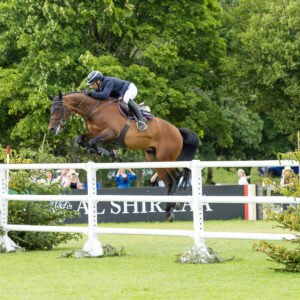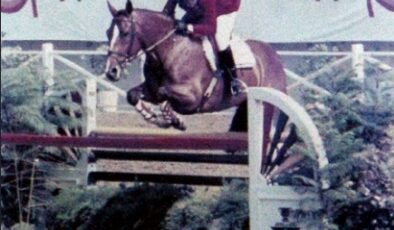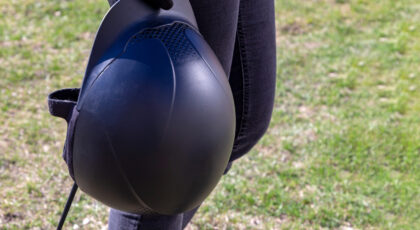Each year, the Keeneland November Breeding Stock Sale becomes the epicenter of the global thoroughbred industry. Pedigree analysts pore over thousands of pages as conformation experts dutifully examine every inch and movement. In an industry of inexact science, these are the methods traditionally relied upon to predict a horse’s potential as an athlete or as a producer of future athletes.
Kerry Thomas is not interested in either of these things. He’s squatting low to the ground, quietly observing the weanling colt parading before him. Thomas is not studying the horse’s legs, feet or shoulders. That task is reserved for business partner Pete Denk. Instead, Thomas is looking him squarely in the eyes.
“If physical conformation tells you what the horse is, emotional conformation tells you who the horse is,” he asserts. “The mental capacity of the equine controls the physical output of the athlete. So if you’re a potential buyer, why wouldn’t you want this information before you make the purchase?”
This is the niche Thomas and Denk have carved out within the industry since establishing THT Bloodstock a few years ago. Denk’s extensive racing industry experience and knowledge was key to getting a foot in the door, while Thomas’s expertise offers an alternative route to defining potential. The Cochranville, PA native is the requisite industry maverick, from his signature Australian bush hat to his background not in racing, but decades of studying horse psychology and herd dynamics in nature.
Thomas’s methods began to gain industry traction in 2011, when he and Denk teamed up to publish The Derby Report, which offered Thomas’s psychological evaluation of each Kentucky Derby contender based on the herd dynamics he observed in their previous races.
Here is what Thomas said of eventual longshot winner Animal Kingdom days before the 2011 Derby:
“This horse’s mental capacity rises to the occasion, and he doesn’t miss a step. They could take this horse overseas. He could run 1 1/2 miles or longer. He has a very broad running style, but he remains controlled in any circumstance…It will be a hell of a battle to watch if he and Dialed In hook up in the Derby. Those two have the most complete emotional conformation profiles in this race.”
And the following year, Thomas pegged another hopeful with long odds named I’ll Have Another:
“He’s very in control. He’s not a horse that wastes any emotional energy. Psychologically, this horse was born to run a classic distance. His tenacity is subtle, because he does it with presence. I look for big things from this horse, and I would not overlook him in the Derby.”
Thomas is quick to point out his job is not to tout winners (he doesn’t even bet), but share his observations and opinions. The results speak for themselves. At the 2013 Keeneland September Yearling Sale, THT Bloodstock recommended just four horses to their client from a catalog of thousands as having the emotional and physical “it” factors for success. One of which was a colt out of the yet unproven sire Super Saver. A couple years and $1.5 million in earnings later, that colt, Runhappy, now occupies the same stall once reserved for Bold Ruler and Secretariat as he begins his stud career at famed Claiborne Farm.
Clearly, the pair have tapped into a fountain of knowledge that’s largely been brushed aside or altogether ignored within the industry.
While the study of herd dynamics and behavior is nothing new, it is certainly unconventional theory in horse sports. THT Bloodstock has a growing roster of international clients and Thomas applies his research to all disciplines. He’s even begun to coach riders.

Denk (left) and Thomas (middle) at the Keeneland November sale.
The psychology of sport and competition is infinitely intricate and interesting, and even more so when you add another complex creature to the equation. So I caught up with Thomas and Denk at the Keeneland November sale to dig a little deeper into their process.
***
Q: What exactly is “emotional conformation” and why does it matter?
Kerry Thomas: To me it’s a vital part of who the horse is. We’re not talking about race cars here. We’re talking about an emotional athlete that is reflective of their environment. And their sensory system, the way they handle stress, assimilate to new environments, this all has a key role in their physical output. The unique thing about it is how patterns of behavior translate to patterns of motion. Whatever your discipline is, whatever you’re trying to do, the operating system—which is the psychology of your horse—is in charge of that body. I’m looking for the continuity between the emotional athlete and the ability of the physical athlete so that one can optimize the other. You can have a great car, but without a pilot or driver, you just have a car.
Q: Can a horse with superior physical ability overcome psychological inadequacies?
KT: Yes, they can and occasionally do, but there’s obviously more of a ceiling on what you can do. We refer to those horses as ‘athletes inside a box’. As long as your price point and what you’re intending to do with those horses is real, then you can get really good athletes that have sensory and psychological issues, but there’s less versatility.
Pete Denk: If you had a Grade I caliber physical horse with an extremely inefficient sensory system, you might wind up with an allowance level horse.
KT: The same things apply across all disciplines. As you increase competition demands, you increase psychological demands. It’s just like with people. Once you get to a certain level the dividing line is not the physical ability of these athletes, its the psychological ability. It’s the difference in being able to get a hit in the bottom of the 9th, and not being able to. The closer the athletes become in their physical abilities, the dividing factor begins to shift to their psychological strengths; things we call grit, will-power, class, heart.
High level horses have the ability to influence other horses without being influenced themselves. The main difference between elite herd dynamic athletes and their counterparts is how they’re able to impress their will upon the world around them. They are able to conserve their emotional energy, which gives them an edge over their peers in competition. You can have an animal with tons of emotional energy but how is it being dispersed? Where’s it going? Horses are stamped mentally as much as they are physically, which is why I believe that if you’re doing a breeding program and you’re not considering the psychological part of the horse in that program, you’re removing 50% of your investment strategy.

Thomas observing weanlings at Taylor Made Farm in 2014. This filly in particular grabbed his attention. A full sister to American Pharoah, later named American Cleopatra. (courtesy of THT Bloodstock)
Q: How much do horses perceive competition? Do they know when they win and lose, or feel when the stakes are higher than usual?
KT: Their understanding of the environment is obviously different than ours, but they have a sense of what’s going on. They can sense the emotions of everyone around them and obviously when you win, everyone is going to be happier; there’s high energy and they feed off that. Same with negativity. So you always have to remember they’re feeling you before they’re seeing you. They also are very responsive to each other. That herd hierarchy is always present—they’ll eye each other up, feed off each other, target one another—like kids turned loose on a playground.
Q: Horse sports are one of the few that regularly pit males against females. How does this dynamic impact behavior in competition?
Female to female, there’s a different dynamic influence taking place. With females there’s more of a group herd dynamic influence, and with males there’s more of an individual herd dynamic. That’s based off their natural propensities in a herd, their natural instincts. Females are more family oriented, males are more individual, that’s their job in a herd. Based upon those principals you have that structure going on when they are competing against each other.
Q: Are there any major differences in the psychological conformation of warmbloods vs. hot-bloods?
The difference I’ve found is in what I call the psychological rhythms of a horse. It’s the speed of which the psychology is processing the environmental stimuli. The basic instincts are all there for every horse, but the speed of that process is what is different.
“The main difference between elite herd dynamic athletes and their counterparts is how they’re able to impress their will upon the world around them.”
Q: Is there a defined age range in which most horses reach mental maturity?
There’s not an exact age range. In my opinion, males have a tendency to mature a little bit later—4, 5, 6 years old…because of their roles in nature. You have to remember that in nature a male will be kicked out of the herd and run in a bachelor herd until they’re 2, 3, 4 years old. So because of that, their maturity processes are generally a little bit slower on things.
Q: Do you think horses are better visual learners, auditory, or something else?
KT: Horses learn best by association, in my opinion. I don’t think there’s one sensory aspect that is more controlling than others. Really it’s the efficiency of the whole sensory system working together. The sensory system needs to hand off stimulus from place to place. If a horse has any gaps in that sequence they lean upon the environment to fill that gap. One of our main jobs is to identify the sensory sequence and how efficient they are, and look for potholes and see how that might affect physical performance.
PD: We probably see vision as the most dominant sense, but horses who rely on vision are not always the most efficient. They often rely on it too much.
KT: just like people are right or left handed, horses have tendencies. What we do is identify those tendencies and predict how they will impact performance.
“I don’t consider myself an expert, I’m a student. We’re constantly learning.”
Q: Horse people like to lump horses into personality types. Obviously every horse has their own unique personality, but what are some of the more common personality types you come across?
I look at it as there are horses who can absorb to their environment and horses that react to the environment, and within those are lots of different layers. Herd leaders have a tendency to be more absorbing, and it has a lot to do with personality traits. Just like some people chew their fingernails, some horses are cribbers. We always want to know the cause but maybe sometimes it’s just an ‘is’. One of the key things we look at is the assimilation process. Not every personality type adapts to their environment at the same rate.
“I find Thoroughbreds to be one of the most willing and compliant psychologies out there. They’ll run through the fire with you, if managed correctly.”
Q: We are seeing an uptick in ex-racehorses being re-trained for sport horse careers. Are there any specific training methods you recommend to improve emotional conformation?
KT: The psychological wellness of your horse, the sensory strength of your horse, is really the first thing you need to ascertain. Where are the dependencies? This governs probability of success whether they’re going to be an athlete, or transition into a different career, like a therapy horse. You know what the horse is but you need to know who the horse is. There really is no direct line of attacking things unless you understand why. The first thing to do is gather the information. We give that information to the owner and trainer, and develop a program. You always hear about the bombproof horse. I disagree with that. I think that’s dangerous thinking. The moment you become apathetic, something will happen.
Q: The OTTB revival has opened a lot of eyes to the versatility and trainability of the Thoroughbred. What are some common myths and misconceptions about horse psychology you’ve uncovered in your work?
KT: I find Thoroughbreds to be one of the most willing and compliant psychologies out there. They’ll run through the fire with you, if managed correctly.
We look at how horses react to something in the environment, and we see them react different ways. Sometimes you’ll see the ripple effect where one horse reacts a certain way all the other horses in the vicinity will react the same way without knowing what’s there. There’s underlying reasons why these things happen, why five or six horses will react the same way over something that’s not even there and one will absorb it. One of the most misunderstood things is the body language. We know how important it is, but it’s a language all its own with many different emotional inflections upon it, and if you don’t really pay attention to those you can misinterpret that language.
PD: I think one of the most misunderstood areas is physical dominance. A lot of people come to us with a horse who is physically dominant with other horses and humans out in the field, and they think that means the horse has a high herd dynamic or is a natural leader. And very often that is not the case. It’s often behavior covering a weakness.
TH: It’s like how the loudest kid in the room might be trying to hide their insecurities. If you think about it, horses are a herd animal designed to live in nature in open space. One of the keys to survival in a predatory environment is to conceal leadership. Well, how do you do that in open space? You conceal it by nonphysical action. A predator might be more apt to approach the animals making the most noise, because in nature you can afford to lose your underlings, but the health of the herd depends on the leaders.
PD: The really high level stallions can really influence the movement of other horses usually without touching them. They don’t have to resort to it.
KT: There are lots of parallels with human psychology, which is why horses make such great therapy animals.
“We’re not talking about race cars here. We’re talking about an emotional athlete that is reflective of their environment.”
Q: The horse industry is notoriously reluctant to embrace new ideas. How has your work been received?
KT: It’s never easy being a new pebble in an old pond, but it doesn’t mean that innovation is not warranted. For me, personally, I learned about horses through nature. I don’t consider myself an expert, I’m a student. We’re constantly learning. We collect all the data and along the way we have been tracking things like what psychological and sensory skills are vital to which disciplines, and how they will impact performance. So as this data keeps rolling in, I think more and more people will be drawn to it.
PD: It’s definitely been a challenge, and we’ve had to prove ourselves. The first thing Kerry and I did was the Derby Report, looking at how the horses’s emotions and sensory efficiency might effect them on a big race day. And I think that’s been a great starting point and really got people to agree that yes, personality and mentality can matter, especially on this huge race day when horses are doing something they’ve never done before in conditions they’ve never faced. It’s been hard to get people to buy in, but at the same time, not many people are going to argue that the mental side of any kind of athletics isn’t important because it is. We’re not trying to reinvent the wheel, we’re just trying to understand it.
***
To learn more about THT Bloodstock and its methods and services, visit thtbloodstock.com.


 November 15, 2016
November 15, 2016 

























